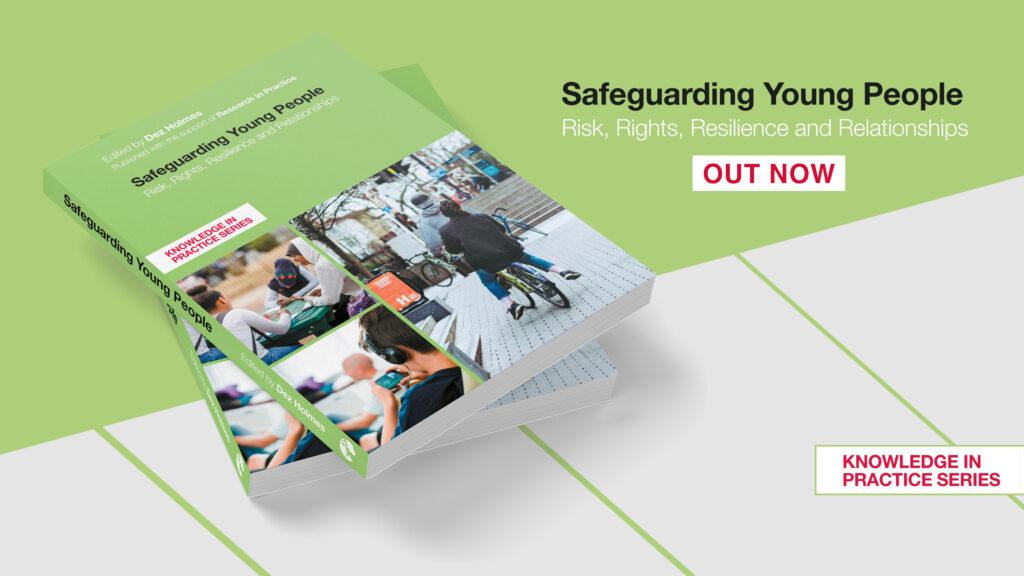
Work with young people facing harm is an ever-evolving area of work, where the stakes are high and where policy and practice are often developed in response to crisis, leading to reactive and defensive approaches. The book I have edited – Safeguarding Young People: Risk, rights, relationships and resilience – tries to take a step back; to create space for reflection to allow a more aspirational and evidence-informed reframing of the issues. It is not a ‘how-to’ guide for practice – instead it takes a whole system view and aims to promote critical thinking, rather than simplistic solutions.
The title of this book argues that, in our efforts to safeguard young people, there is a danger of focusing on risk without taking into account three other crucial factors relevant to a young person’s sense of safety: their rights, their relationships, and their resilience.
To focus on risk without considering a young person’s rights is to undermine their citizenship. Within children’s safeguarding much is made of the paramountcy of ‘the welfare of the child’, whereas in safeguarding adults, there is perhaps a clearer recognition that welfare is one aspect of wider wellbeing, and the right to safety must be considered in balance with other rights, such as privacy and freedom. As discussed in Cocker, Cooper and Holmes’ chapter, within the sphere of safeguarding adults, the notion of balancing risk and rights is more explicitly established. Furthermore, as discussed in both Wroe and Pearce’s chapter and in Davis and Marsh’s chapter, a rights-based perspective requires us to engage with and actively seek to redress the structural disadvantages and discrimination facing many young people and their communities.
To focus on risk without considering young people’s relational identities, is to dislocate them from protective actors in their lives. Human beings do not exist in a vacuum; our families, our peers and communities all influence our safety and wellbeing. Developing a sense of relational identity is a key part of being a teenager, as Hagell and Coleman highlight in their chapter on adolescent development. Relationships can be seen as both a source of harm and trauma for some young people, and are an important vehicle for repair and recovery within a trauma-informed approach, as explored in Hickle and Lefevre’s chapter. Creating safeguarding responses that recognise the social and relational context in which young people can face harm requires us to adopt a systems-perspective, and this is not necessarily well supported by current legislative and policy frameworks, as Firmin and Knowles’ chapter discusses.
To focus on risk without promoting a young person’s resilience is to undermine their sense of agency, and – at worst – can mirror the coercive dynamics of exploitation. As Hill and Warrington explore in their chapter, young people facing, and recovering from, harm need to be afforded as much choice and control as possible. This requires nuanced and thoughtful practice, which in turn requires nuanced and thoughtful local leadership and national policy. This work can be anxiety-provoking, complex and emotionally painful; it is understandable that professionals facing these challenges might seek to exert control, subtly or overtly. When we treat young people as passive recipients of safeguarding efforts – instead of active partners – we can undermine their sense of self-efficacy and resilience. Importantly, in keeping with the structural lens of this book, resilience must be understood as the galvanising of internal and external resources (Pooley & Cohen, 2010); it is not a substitute for support.
Taken together the chapters emphasise that effective safeguarding of young people requires us to hold a ‘both/and’ mindset:
- considering structural influences as well as ensuring a focus on the individual circumstances and wishes of the young person;
- affording young people a degree of choice and control as well as being explicitly clear about our duty to protect them;
- recognising that in terms of discrimination professionals might be both part of the problem as well as being a key part of the solution
- being bold enough to push for radical whole-system reform as well as taking responsibility for immediate change ourselves, however small that change might be.
Drawing on the diverse perspectives of chapter authors, we have tried to strike a balance between support and challenge. It should be possible for the reader to find at least one point they disagree with, and hopefully many more that affirm and inspire.
Safeguarding Young People is edited by Dez Holmes. Published by Jessica Kingsley Publishers 21st March 2022. £19.99.